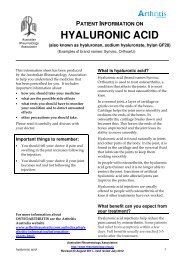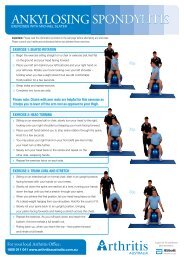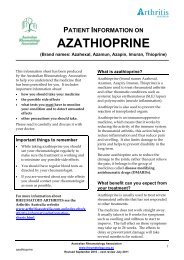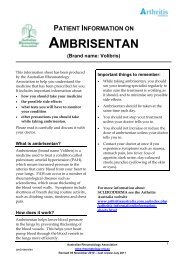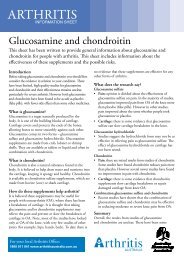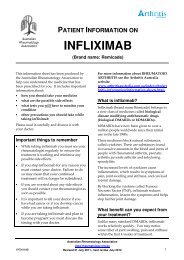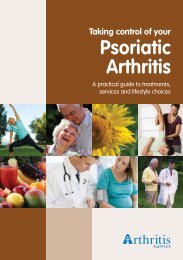PREDNISOLONE & PREDNISONE
PREDNISOLONE & PREDNISONE
PREDNISOLONE & PREDNISONE
- No tags were found...
You also want an ePaper? Increase the reach of your titles
YUMPU automatically turns print PDFs into web optimized ePapers that Google loves.
PATIENT INFORMATION ONAustralianRheumatologyAssociation<strong>PREDNISOLONE</strong>& <strong>PREDNISONE</strong>(Also known as corticosteroids / cortisone / steroids)(Examples of brand names: Panafcort, Panafcortelone, Predsone, Predsolone, Solone, Sone)This information sheet has been produced bythe Australian Rheumatology Association tohelp you understand the medicine that hasbeen prescribed for you. It includes importantinformation about:• how you should take your medicine• what are the possible side effects• what tests you should have to monitoryour condition and to detect unwantedeffects• other precautions you should take.Please read it carefully and discuss it withyour doctor.Important things to remember:• While taking prednisolone, you should seeyour treating doctor regularly to makesure the treatment is working as it should,and to minimise any possible side effects.• You should not stop your treatment unlessyour doctor tells you to.• You should not increase or reduce the doseof prednisolone unless your doctor tellsyou to.For more information about RHEUMATOIDARTHRITIS see the Arthritis Australiawebsitewww.arthritisaustralia.com.au/index.php/arthritis-information/information-sheets.html.What is prednisolone?Corticosteroids are hormones, which areproduced naturally in the body. They arenecessary for normal working of the body.Prednisolone and prednisone are man-madecorticosteroids (also called steroids for short).Man-made corticosteroids are used to treatinflammatory diseases such as rheumatoidarthritis (RA), systemic lupus erythematosus(SLE/lupus) and other inflammatory disease.They have a strong anti-inflammatory effectand reduce the swelling and pain in joints andother organs. They do not cure the disease.They should not be confused with male orfemale steroid hormones, which are known fortheir misuse among athletes.Prednisolone is the most common type ofcorticosteroid prescribed. Althoughprednisone is slightly different, theinformation contained in this document alsoapplies to that medication.What benefit can you expect fromyour treatment?Prednisolone works very quickly. Within afew days you may notice your pain andstiffness is much better and/or your joints areless swollen.Australian Rheumatology Associationprednisolone 1http://www.rheumatology.org.auRevised 23 August 2011 – next review July 2012
may be recommended if vitamin Dlevels are low.• Skin: The skin, especially on the arms andlegs, can become thin, easily bruised andslow to heal. This occurs particularly afterlong term use, on higher doses and inolder people with skin problems related toaging. In younger people, acne may be aproblem.• Diabetes: Prednisolone can cause a rise inblood sugar in people with diabetes. Thismay require a change in their diabetesmedicine. You should consult your generalpractitioner (GP) if you experience anincrease in blood sugar levels.Prednisolone can also cause the onset ofdiabetic symptoms in people who are atrisk of diabetes.• Blood pressure: Prednisolone may cause anincrease in blood pressure or make it moredifficult to control. This can be monitored,and changes can be made to your bloodpressure medicine if required. Your doctorwill advise about frequency of monitoring.• Cholesterol: Prednisolone can cause a rise inblood cholesterol. This can be monitored,and changes can be made to yourtreatment if required.• Psychological effects: Prednisolone can causeeuphoria (feeling high) and/or other moodor personality changes such as irritability,agitation or depression. While somepsychological effects are quite common,they rarely cause significant problems.• Trouble sleeping may also occur but can beminimised by taking prednisolone in themorning.• Infections: There may be an increased riskof some infections, including mouthinfections (such as thrush), shingles andlung infections. Pre-existing infectionssuch as tuberculosis (TB) may becomeactive again. It is important to tell yourdoctor if you have a chronic infection oryou have been exposed to TB earlier inyour life.• Indigestion or heartburn can occur. Takingprednisolone with food can reduce this.• Ulcers: If taken with nonsteroidal antiinflammatorymedicines (NSAIDs),prednisolone can further increase the riskof stomach or duodenal ulcers. Your doctorwill advise you about how to reduce thisrisk and about what symptoms to look outfor.Less common or rare possible side effects• Eyes: With long term high dose treatmentprednisolone may increase development ofcataracts.• Other: Facial flushes, constipation andavascular necrosis (a painful bonecondition usually seen in the hip or knee)can occur very rarely.Many of the above side effects can bemanaged or prevented by close medicalsupervision and by following your doctor’srecommendations (see also Precautions,below).What precautions are necessary?Tests• Blood sugar and cholesterol levels can beincreased by prednisolone, so you willneed to have blood tests to check theselevels. Your doctor will tell you when theblood tests are required.• Your GP will be told about the tests youneed to have. It is important to see yourGP if you have been asked to do so as theyhave an important role to play inmonitoring your condition.Use in pregnancy and breastfeeding• Prednisolone may be used safely inpregnancy and breastfeeding. It isimportant to tell your doctor if you are, orintend to become pregnant or if you arebreastfeeding.Use with other medicines• Prednisolone can affect how othermedicines work. You should tell yourdoctor (including your GP, rheumatologistand others) about all medicines you aretaking or plan to take. This includes overthe counter or herbal/naturopathicmedicines.Australian Rheumatology Associationprednisolone 3http://www.rheumatology.org.auRevised 23 August 2011 – next review July 2012
• You should also mention your treatmentwhen you see other health professionals,even if you have stopped takingcorticosteroids within the last 12 months.• Most vaccines can be given safely withprednisolone. Talk with yourrheumatologist before receiving anyvaccines.• Yearly flu vaccines and Pneumovax aresafe and recommended.Surgery• If you are going to have an operation it isimportant to tell the anaesthetist that youare taking or have been takingprednisolone or other corticosteroids in thelast year. Your doctor may tell you thatyou need some additional prednisolone atthe time of surgery.Never stop taking prednisolone suddenly• You should not stop taking prednisonesuddenly or increase or reduce the doseyou have been prescribed unless yourdoctor tells you to.• Your adrenal glands, which are just abovethe kidneys, normally make corticosteroidsin small amounts. These are important formany normal body functions.• If prescribed corticosteroids are taken, thebody begins to make less than usual oreven stops making corticosteroidscompletely.• If the medicine is then suddenly stoppedthere may be a problem as the adrenalglands won’t have had time to make thecorticosteroids needed. This problem iscalled adrenal insufficiency.• Signs of adrenal insufficiency includeweakness, fatigue, fever, weight loss,vomiting, diarrhoea and abdominal pain.If you experience any of these problems,seek medical help.How to store prednisolone• Store prednisolone tablets at roomtemperature, away from heat, moistureand light (e.g. not in the bathroom).• Keep all medicines out of reach ofchildren.Questions?If you have any questions or concerns writethem down and discuss them with yourdoctor.Your doctor’s contact detailsIf you are taking prednisolone or othercorticosteroids you should see yourrheumatologist regularly to make sure thetreatment is working and to minimise anypossible side effects.The information in this sheet has been obtained from various sources and has been reviewed by the Australian Rheumatology Association. It isintended as an educational aid and does not cover all possible uses, actions, precautions, side effects, or interactions of the medicinesmentioned. This information is not intended as medical advice for individual problems nor for making an individual assessment of the risks andbenefits of taking a particular medicine. It can be reproduced in its entirety but cannot be altered without permission from the ARA.The NHMRC publication: How to present the evidence for consumers: preparation of consumer publications (2000) was used as a guide indeveloping this publication.Australian Rheumatology Associationprednisolone 4http://www.rheumatology.org.auRevised 23 August 2011 – next review July 2012



